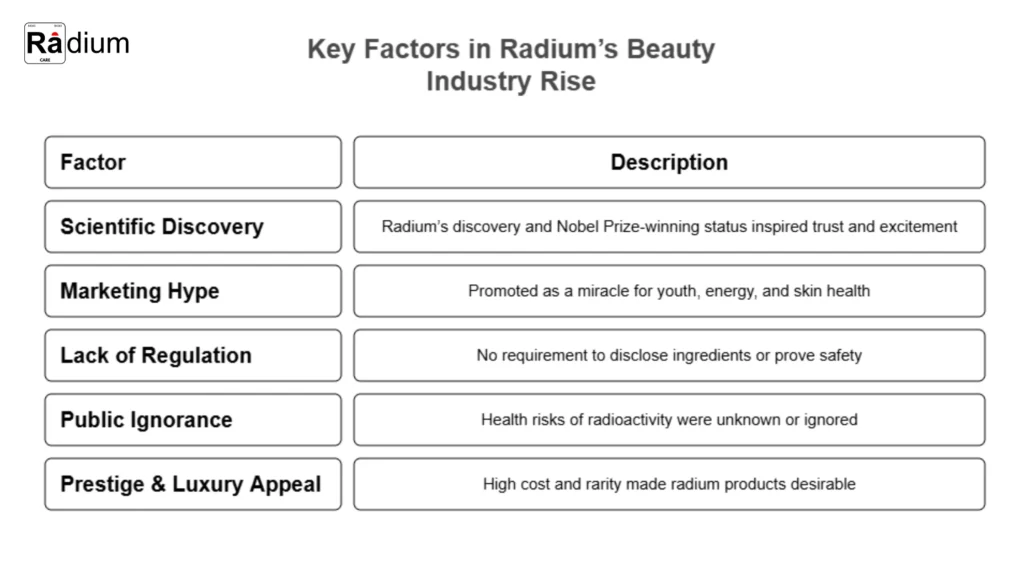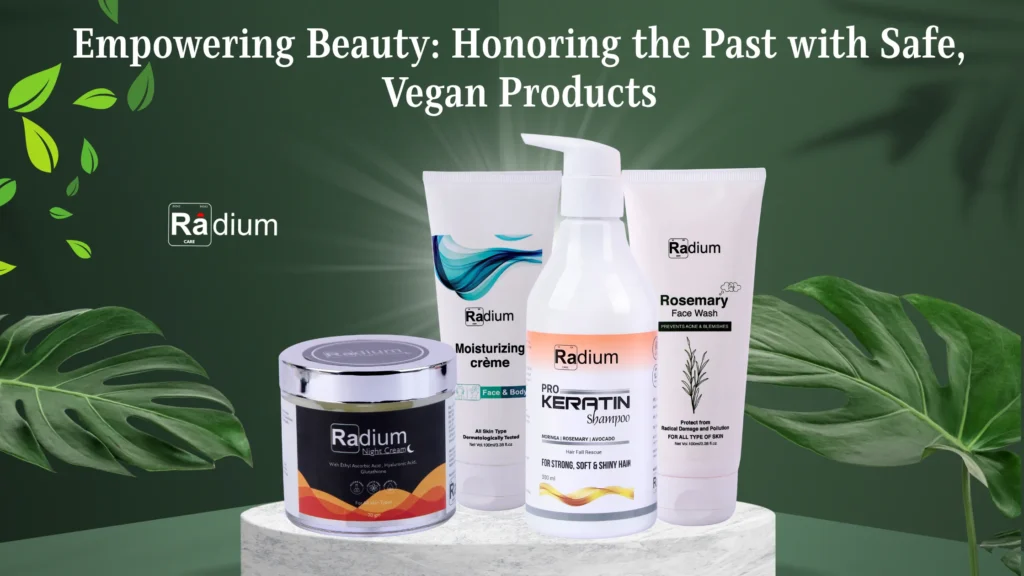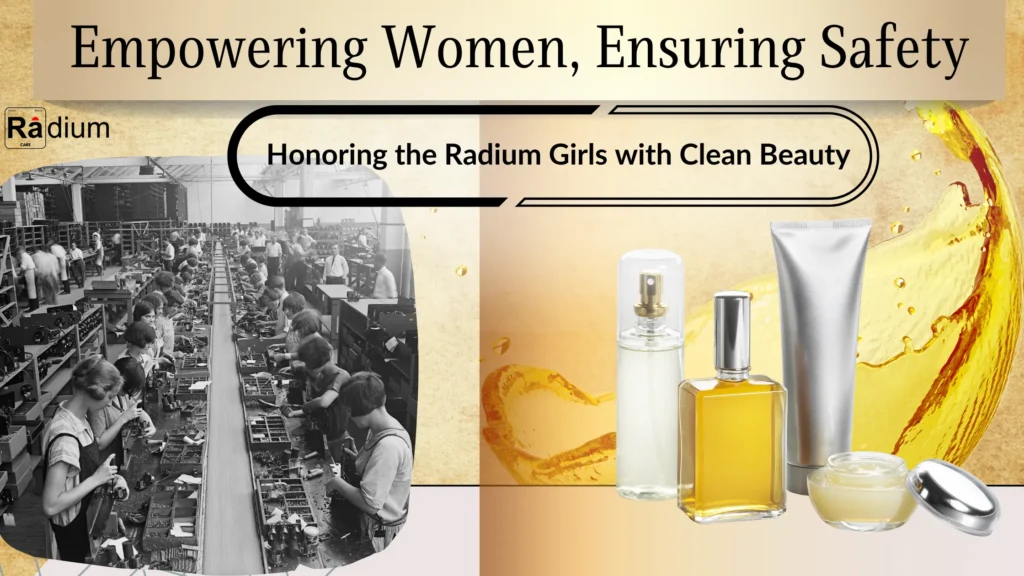The Radium Girls were young women in the 1920s who painted watch dials with radium-containing paint without knowing how dangerous it was. Ingesting radium every day, many of them got very sick and died. While their employers denied it, these young women’s quest for justice led to historic labor laws and reforms around safer working conditions that saved thousands of lives and laid a foundation for modern worker protections.Their legacy is built in inspiration around determination and activism for safe and ethical workplaces standards and safer consumer products like cruelty-free cosmetics, which prioritize health, transparency, and compassion.
The radium girls are a bittersweet moment in the history of industry, their plight serves as a reminder of the pitfalls of unbridled invention; and also the relentless power of social pressure. In their role as young women hired to paint luminous watch dials, the radium girls experienced not only unimaginable physical harm, but also initiated changes that have transformed working conditions and labor legislation world-wide.
From Miracle to Menace: Radium’s Rise in Beauty Products
- Scientific Hype and Misconceptions
Early 20th-century science marketed radium as a miracle treatment for a host of diseases, including cancer and tuberculosis. The beauty sector, not to be left behind in the pursuit of staying scientifically current, started marketing radium as a revolutionary new ingredient for rejuvenation, youthfulness, and skin health.
- Marketing and Product Development
Radium was marketed as “liquid sunshine” and a fountain of glowing beauty, with promises it would:
- Produce collagen and elastin to plump up youthful skin
- Detoxify the body
- Remove wrinkles and revitalize tissue
Companies such as Radior, Tho-Radia, and Artes marketed creams, powders, soaps, and even toothpaste with radium or its derivatives. Advertisers tended to appeal to science when they said things like “a wonderful conquest of science in the service of beauty” to entice consumers.
- Lack of Regulation and Public Awareness
Cosmetics were not well regulated at the time, and as long as companies did not make overtly therapeutic claims, the companies did not have to disclose ingredients or prove safety. This absence of oversight made it impossible for consumers to distinguish between dangerous formulations and what we today define as safe cosmetics—products backed by transparency, testing, and non-toxic ingredients Radioactivity was not yet known to pose dangers, and radium was frequently labeled as a natural element instead of a drug, so its incorporation into consumer products could take place without supervision.
- Popularity and Decline
The beauty of glowing, young-looking skin and the luxury of applying a “scientific” substance rendered radium-based cosmetics fashionable during the 1920s and 1930s, particularly in the United States and Europe. As the risks to health came tragically into focus—most importantly through the plight of the Radium Girls and other high-profile instances—public opinion was turned against them, and controls later prohibited radioactive substances in cosmetics.
Summary Table: Key Factors in Radium’s Success in the Beauty Industry

The Cost of Glow: The Radium Girls’ Tragedy
Who Were the Radium Girls?
During the early 20th century, radium was a miracle element that fascinated people with its glowing nature. Watch factories in New Jersey, Illinois, and Connecticut hired thousands of young women to paint watch dials and instrument dials with radium-based paint, which made them shine in the dark, an entrancing sight. The job was not only prestigious but well paid too, providing women with a chance at financial independence, providing women with a chance at financial independence and reflecting early forms of women empowerment through industrial employment—despite the risks they unknowingly faced.The radiating beauty of radium and the promise of an improved standard of living attracted many to work there, oblivious to the secret dangers hidden in the radiant material they worked with every day.
The Struggle and Suffering
The painting technique had to be accurate, so the laborers were instructed by supervisors to “lip-point” their brushes—shaping the bristles with their lips after each dip in the radium paint. The women ingested minute quantities of radium on a daily basis; for them, it was ingested unknowingly At last, they developed severe diseases: anemia, bone fracture, necrosis of their jaw, and finally death. Companies denied responsibility for any of the above outcomes and misled workers on the dangers they faced.
Health Impact in Numbers:
- Deaths Attributed to Radium:At least 112 estimated dial painters in the United States
- Early Death: At least 50 women died from radium paint poisoning between 1927
- Scale of Exposure: Researchers tracked 1,285 women that were dial painters pre-1930 that had a high cancer rate
- Demographics: Most women were in their early 20’s, and either newly married or had younger children
These data highlights the significant health risk of radium exposure at work as a health and industry hazard.
From Suffering to Strength: The Fight for Justice
As death tolls and sicknesses mounted, the Radium Girls fought back and organized.In 1925, 5 women from New Jersey filed a groundbreaking lawsuit against the United States. In spite of company efforts to stall the trial until the women passed away, the case was a national sensation.Even though they were suffering crippling injury, their bravery ignited public indignation and lawsuits.
One of those scientists, Dr. Harrison Martland, trained by the NIST, was instrumental in making the association between the women’s sickness and radium exposure and came up with the scientific proof needed to bring the companies to court. The eventual settlement only offered partial compensation but set a precedent for workers’ rights and corporate accountability.
Impact on Labor Laws and Workplace Safety
The Radium Girls case resulted in significant changes to occupational health and safety laws and was instrumental in the creation of the Occupational Safety and Health Administration (OSHA) and instigated worldwide changes to workplace laws and policies. The disaster underscored how important it was that workers be protected from deadly chemicals, and placed the responsibility squarely in the hands of the employers when it came to the health of their workers.
A Modern Legacy: Safe and Ethical Beauty
The story of the Radium Girls is a troubling reminder of the urgent need for safety, transparency, and ethical responsibility in the pharmaceutical and beauty industries. At the outset of the early 20th century, young women contracted to paint watch dials with radium-based paint were severely affected by exposure to the toxic substance was a harrowing reminder of the consequences of a lack of regulation.Here at Radium Care, we pay tribute to the memories of these brave women by holding ourselves to standards of products that reflect authentic beauty—cruelty-free, sulfate-free, paraben-free, and 100% vegan.
Beauty must never come at a health cost. The tragic history of the Radium Girls reminds us of the dangers of toxic ingredients in beauty products. Today, the trend for clean, cruelty-free, and vegan beauty focuses on consumer safety and ethical practice. When we endorse cruelty-free cosmetics, we are saying boldly that we reject animal testing while still providing formulas safe for any skin type. When we choose toxin-free products, we protect not only our skin, but we also protect our health, and the world around us. Radium Care undertakes this responsibility by providing safe, transparent, and ethical beauty solutions. Our promise empowers women to own their beauty with confidence, without compromising on health or principles, so that the history books teach us to move in a safer, more ethical direction for everyone.
How We Uphold Their Legacy

1. Cruelty-Free Standards
- No Animal Testing: We will never test our products or ingredients on animals at any point. We have additional support from reputable third-party organizations with respected cruelty-free certifications (e.g. Leaping Bunny, PETA’s Beauty Without Bunnies program) that have similar support.
- Supplier Transparency: All suppliers must provide cruelty-free criteria and must guarantee that everything is ethically sourced and nothing has been tested on an animal
2. Vegan and Clean Formulations
- 100% Vegan: There are no animal ingredients in any of our products; we strictly comply with the definitions of vegan required to offer Vegan Society or the American Cosmetic Association vegan certifications.
- Sulfate-Free and Paraben-Free: We do not use toxic chemicals that have health and environmental implications, (or any other toxic chemicals) sulfates or parabens.
- No Harmful Additives: Our formulations do not contain toxic additives, such as phthalates or synthetic fragrance, which do not provide any value to the safety and wellbeing of the consumer.
3. Transparency and Certification
- Clear Labeling: All required labels to inform the consumer are visible on our products.
- Third-Party Audits: We receive audits regularly, and we possess documentation to prove compliance of the highest level for safety and ethical standards.
4. Empowering Women, Protecting the Future
- Ethical Sourcing: We responsibly source our ingredients and support sustainable projects to protect people and the planet.
- Advocacy: By sharing the stories of the radium girls, we raise awareness and support workplace safety and ethical production in beauty while making sure they continue to be present to inspire change.
- Women Empowerment Through Ethical Beauty: We celebrate the Radium Girls by providing opportunities for women in safe, dignified, and empowering positions -from sourcing ingredients, to leading in our company.
Conclusion: Their Courage, Our Commitment
The radium girls endured incredible suffering and their courage changed the world. Their pursuit of justice did not only expose the dangers of radium but also established a foundation for the labor protection we have today. Legacy and memory lives on in every safe, ethical, and empowering product we create in their honor.
By committing to cruelty-free, vegan, and clean beauty, we are able to pay tribute to the radium girls in deed and name. We pledge that beauty will never be at the expense of health, safety, or ethics, and recognize the women whose bravery enabled the creation of a safer world for everyone.
FAQ’s
Que: Who were the Radium Girls?
Ans: The Radium Girls were young women working in factories in the 1920s painting watch dials in glow-in-the-dark radium paint. The women were instructed to “lip-point” their brushes, which resulted in them unknowingly ingesting a small amount of radium every day.
Que: Was radium used in beauty products?
Ans: Yes, there were even beauty products marketed with radium, marketed as a “miracle cure” and a revolutionary ingredient. Companies sold creams, powders, soaps, and toothpaste with radium and claimed it could detoxify, get rid of wrinkles, stimulate collagen, and energize tissue.
Que: Why was radium used in cosmetics despite its dangers?
Ans: Companies didn’t have regulations at that time in the cosmetics industry, so it appears the radioactivity danger was either not understood or overlooked.
Que: What does “clean beauty” mean for Radium Care?
Ans: “Clean beauty” means we pursue consumer safety and ethical standards at Radium Care. Our products are free from toxic chemicals such as sulfates and parabens, are 100% vegan, and we never test on animals.
Que: How does “Radium Care” honor the legacy of the Radium Girls?
Ans: “Radium Care” will honor the legacy of the Radium Girls by being committed to safe, transparent, and ethical beauty products. We strive to ensure that beauty never comes at the cost of health, safety, or ethics, embodying true beauty

